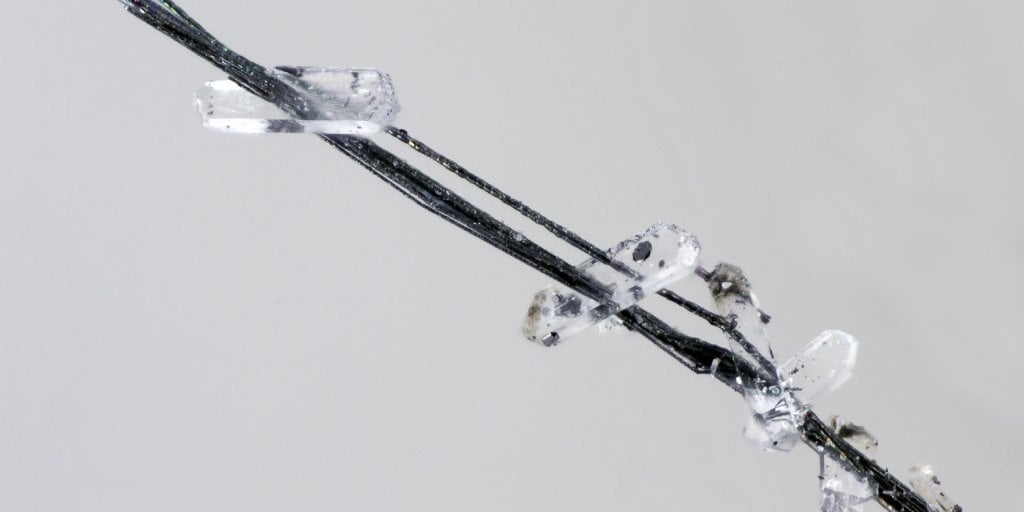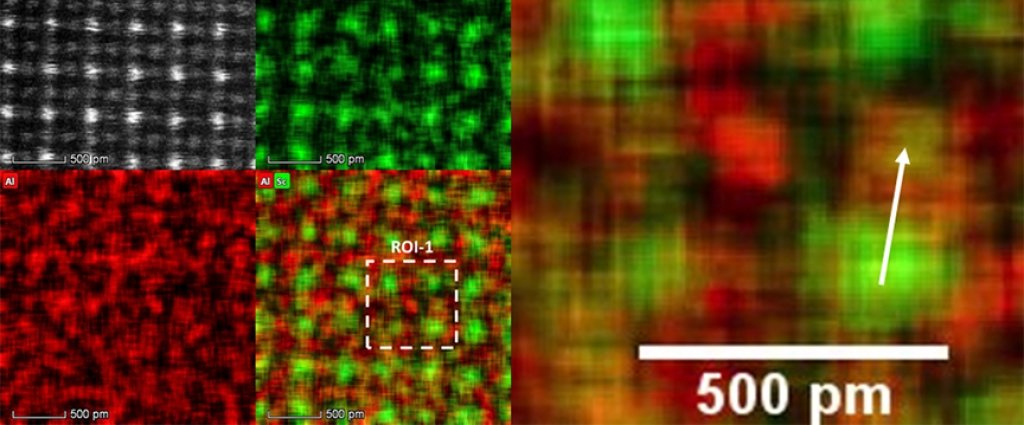Don't judge a mineral by its cover. Because that fine, hair-like coating might turn out to be a new mineral.
At least that was the case with the newly named merelaniite, a cylindrite-group mineral discovered by a team of researchers led by John Jaszczak, a professor of physics at Michigan Tech. The tiny gray whiskers of merelaniite had been around a while, but had probably been regularly cleaned off larger, better-known crystals like the gemstone tanzanite. The name of the new mineral was chosen by Jaszczak and his colleagues after the township of Mererani, known more commonly in the mineral and gemological communities as “Merelani,” in honor of the local miners working in the nearby tanzanite gem mines in northern Tanzania where the new mineral occurs.
The first person to spot the tiny mineral was Jessica Simonoff in 2011. Then 14 years old, she and her mineral-enthusiast father, Bob Simonoff, didn’t recognize the whiskers. So, they brought the sample to Jessica’s mineralogy internship supervisor Mike Wise at the Smithsonian Institution’s National Museum of Natural History. Because of the high levels of molybdenum and sulfur, the team suspected the mineral was an unusual form of the mineral molybdenite. But when Jaszczak saw the mineral’s photo in a news brief, he suspected otherwise.
“The long, thin wires of the minerals’ shape was very unusual,” says Jaszczak, who had already been studying molybdenite extensively. After meeting the Simonoffs and suggesting that further studies might be in order, Jaszczak received a small sample from Wise. Preliminary Raman spectrometry gave spectra that didn’t match any known mineral. Further analyses done in Michigan Tech’s Applied Chemical and Morphological Research Laboratory revealed the presence of not only sulfur and molybdenum, but also a significant amount of lead, and other elements. “It really looked like this was a new mineral,” Jaszczak says.
All in the Family: Cylindrite

“Minerals have a natural wow factor, and while we use many of them daily without thinking twice, some mineral specimens are truly natural works of art,” Jaszczak says, adding that minerals like the gems tanzanite (a blue/purple variety of zoisite) and tsavorite (a green variety of grossular garnet), which come from the same mines as merelaniite, can be more eye-catching. But it doesn’t negate the value of less showy minerals.
Scanning and transmission electron microscope studies of merelaniite—a member of the cylindrite group—revealed a neatly stacked layered structure at the atomic level, with sheets rolled in scrolls like tobacco in a cigar.
“Minerals also have an internal beauty in their crystal structures, and it is the crystal structure that influences their properties,” he explains. “Learning about minerals with unique crystal structures grants insight into the nature of matter, and sometimes leads to new human-made materials, inspired by their naturally occurring counterparts.”
To Name a Mineral
There are 5,179 minerals listed by the International Mineralogical Association, and their Commission on New Minerals, Nomenclature and Classification (CNMNC) receives more than 80 proposals each year for new ones. Many turn out to be variations of existing minerals. To discern the new from the variable, mineralogists and physicists put samples through a battery of rigorous tests, particularly to discern their chemistry and crystal structure.
“It is one thing to find a mineral that is probably new; it is quite another thing to be able to perform all of the required analyses to satisfy the CNMNC for approval of its status and a new name,” Jaszczak says.
Although Raman spectroscopy gave Jaszczak the first hard evidence that the mineral may be new, more work needed to be done. The chemistry of the new mineral was a challenge to determine with precision because of the nature of how molybdenum, sulfur, and lead are detected in the electron microscope’s x-ray detectors. “Ironically, these three elements all give very similar x-ray signatures,” says Jaszczak. Furthermore, because merelaniite is composed of two different kinds of mismatched layers at the atomic scale, and because they curve to form a scroll-like cylindrical structure, it was particularly difficult to determine the fundamental crystallographic parameters. For both of these challenges, Jaszczak needed help.
Additional samples were also needed for further studies. Fortunately, and rather serendipitously, Simon Harrison in Bath, England, with whom Jaszczak had been collaborating on a comprehensive survey of unusual minerals from the Merelani gem mines, had sent Jaszczak a suite of samples to study and photograph in December 2013. On one particularly large sample of alabandite, Jaszczak found a treasure trove of tiny merelaniite whiskers mixed with graphite crystals that provided more than enough material for additional studies.
Details, Details
To help with understanding the crystal structure, Jaszczak turned to Steve Hackney, professor of materials science, and Owen Mills, director of Michigan Tech’s Applied Chemical and Morphological Analysis Laboratory. Hackney was able to provide crucial high-resolution images and diffraction patterns using transmission electron microscopy (TEM) on ultrathin samples prepared by Mills. The goal was to get a more refined sense of the whisker’s atomic structure.

TEM allows a magnified image of the sample compared to other imaging techniques. “Think of it like looking at a beach,” says Hackney. “If you stand up on a chair, you just see tan color, but if you get up real close, then you can start to see how the beach is made of individual grains of sand. The TEM gets us really close.”
That process is about to get easier with a new $1.7 million transmission electron microscope being installed at Michigan Tech. The FEI Themis Titan will be able to discern single atoms in a material. The equipment is so sensitive that the University is building a new space to house it away from interfering noise, vibration, and electronics on the main campus. The mineral-finding crew is excited to test out the new equipment, although Mills and Hackney jokingly reminded Jaszczak that “your samples are still going to need to be thin.”
Sample prep is one of the trickiest parts of the process: Take a several millimeter-long mineral whisker, mount it in epoxy, then slice off nanometer-thin samples with a diamond knife to put on a special grid that plugs into the TEM. There’s a reason Mills had to do about 50 cuts. “Out of all those cuts, only one proved to be successful for imaging on the TEM,” said Jaszczak. It was totally worth it. The high-resolution TEM images confirmed the layered structure, and the diffraction patterns revealed a bimodal set of spots that later proved to be vital to understanding the atomic-level structure. To make sure, Jaszczak brought in additional researchers.
Global Team
Jaszczak teamed up with Mike Rumsey and John Spratt at the Natural History Museum in London to determine the chemical composition of the new mineral with precision.
![John Jaszczak Following their collaboration on merelaniite, Luca Bindi named another new mineral this year jaszczakite [Bi3S3][AuS2] found in the Borzony Mountains in Hungary, and named for Michigan Tech researcher John Jaszczak.](/magazine/research/2017/stories/minerals/image161277-rside.jpg)
To vet the structure, Jaszczak and Rumsey then sought out Luca Bindi, a professor at the Università di Firenze in Italy and an expert in solving complicated crystal structures. The results from Bindi’s x-ray diffraction studies, together with the TEM and chemical data, proved that the mineral was a new member of the cylindrite group, this time with atomic-scale layers of predominantly molybdenum disulfide alternating with layers of lead sulfide—a natural nanocomposite material—according to Hackney.
Future work will be needed to determine exactly how the other elements, including vanadium, antimony, bismuth, and selenium, fit into the structure.
Although not a showcase gem, merelaniite is attractive, and as the analyses show, it has an intricate, microscopic internal beauty as well. Currently, merelaniite have no human-made analog; minerals like it could be their inspiration.
For Jaszczak, simply finding something new is enough. Echoing physicist Richard Feynman, Jaszczak notes, “Science is about taking ‘pleasure in finding things out’ and we’re delighted to have uncovered and described this beautiful new mineral.”
It's Been a Good Year for New Minerals
Michigan Tech, in one way or another, is associated with five new minerals: merelaniite, jaszczakite, redcanyonite, leesite, and leószilárdite. Owen Mills worked with two Michigan Tech alumni, Travis Olds ‘12 and Shawn Carlson ‘91, on the last three. They are all small yellow crystals from Utah’s San Juan Mining District, with some notable differences.
 Leószilárdite
Leószilárdite
Na6Mg(UO2)2(CO3)6•6H2O
(a sodium and magnesium-enriched uranyl carbonate)
Aggregates of bladed crystals up to 0.2 mm in length
Markey Mine, Utah, USA
 Leesite
Leesite
K(H2O)2[(UO2)4O2(OH)5]•3H2O
(it’s a hydrated desert mineral, a companion of gypsum)
Stacked blades, radial aggregates, and occasional powdery masses up to 1 mm in length
Jomac Mine, Utah, USA
 Redcanyonite
Redcanyonite
(NH4)2Mn[(UO2)4O4(SO4)2](H2O)4 (a rare uranyl sulfate)
Needles in radial aggregates
Blue Lizard Mine, Utah, USA
Michigan Technological University is an R1 public research university founded in 1885 in Houghton, and is home to nearly 7,500 students from more than 60 countries around the world. Consistently ranked among the best universities in the country for return on investment, Michigan's flagship technological university offers more than 120 undergraduate and graduate degree programs in science and technology, engineering, computing, forestry, business, health professions, humanities, mathematics, social sciences, and the arts. The rural campus is situated just miles from Lake Superior in Michigan's Upper Peninsula, offering year-round opportunities for outdoor adventure.




